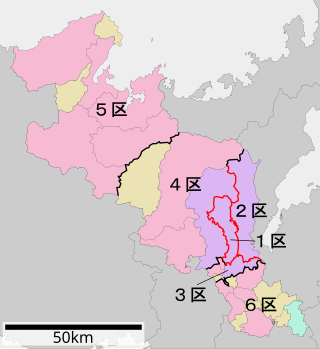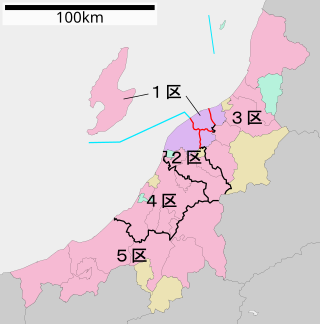
Tokyo 6th district is a constituency of the House of Representatives in the Diet of Japan. It is located in Tokyo, and consists of major parts of the City of Setagaya, one of Tokyo's 23 special wards. With 2.18 times as many voters as Tokushima's 1st district, it had the lowest electoral weight throughout Japan in the election of 2005. In 2007 the Supreme Court dismissed a claim that the election in this and other Tokyo districts was unconstitutional and thus invalid. As of September 2012, 486,353 eligible voters were registered in the district, giving them the third lowest electoral weight in the country.

Tokyo 18th district is a constituency of the House of Representatives in the Diet of Japan. It is located in Western Tokyo and consists of the cities of Musashino, Koganei and Fuchū. Until 2002, it included Mitaka instead of Fuchū. As of 2016, 436,338 eligible voters were registered in the district.

Gunma 1st district is a constituency of the House of Representatives in the Diet of Japan. It is located in Gunma Prefecture and consists of the cities of Maebashi and Numata and the district of Tone as well as parts of the cities of Kiryū, Shibukawa and Midori. As of 2012, 387,120 eligible voters were registered in the district.

The Tokyo 3rd district is a constituency of the House of Representatives in the Diet of Japan. It is located in Tokyo and covers parts of the former city of Tokyo and Tokyo's outlying islands. The district consists of the wards of Shinagawa and parts of Ōta, the towns of Ōshima and Hachijō and the villages of Toshima, Niijima, Kōzushima, Miyake, Mikurajima, Aogashima and Ogasawara. As of 2012, 482,494 eligible voters were registered in the district.

Tokyo 10th district is a constituency of the House of Representatives in the Diet of Japan. As of 2012, 351,821 eligible voters were registered in the district. It covers northwestern parts of the former city of Tokyo. Originally it consisted of the ward of Toshima and parts of Nerima, but after redistricting in 2017 it comprises parts of four wards, Toshima, Nerima, Nakano and Shinjuku.

Tokyo 1st district is a constituency of the House of Representatives in the Diet of Japan. It is located in eastern mainland Tokyo and covers central parts of the former city of Tokyo. The district consists of the wards of Chiyoda, Minato and Shinjuku. As of 2016, 514,974 eligible voters were registered in the district. After redistricting in 2017, a part of Shinjuku was moved to the Tokyo 10th district and a part of Minato was moved to the Tokyo 2nd district.
Kyōto 5th district is a constituency of the House of Representatives in the Diet of Japan. It is located in Kyōto and covers the northwestern part of the prefecture on the Sea of Japan coast. The district consists of the cities of Fukuchiyama, Maizuru, Ayabe, Miyazu and Kyōtango as well as the Yosa District. As of 2012, 254,636 eligible voters were registered in the district.
Kyōto 2nd district is a constituency of the House of Representatives in the Diet of Japan. It is located in central Kyoto and consists of the Kyoto city wards of Sakyō, Higashiyama and Yamashina. As of 2012, 267,926 eligible voters were registered in the district.

Kyōto 3rd district is a constituency of the House of Representatives in the Diet of Japan. It is located in South central Kyoto and consists of Kyoto city's Fushimi ward, the cities of Mukō and Nagaokakyō and the town of Ōyamazaki. As of 2012, 345,260 eligible voters were registered in the district.

Hokkaidō 5th district is a constituency of the House of Representatives in the Diet of Japan. It consists of Atsubetsu ward in Hokkaido's city of Sapporo and Ishikari Subprefecture without Sapporo. As of 2009, 453,752 eligible voters were registered in the district.

The Shikoku proportional representation block is one of eleven proportional representation (PR) "blocks", multi-member constituencies for the House of Representatives in the Diet of Japan. It consists of Shikoku region covering Tokushima, Kagawa, Ehime and Kōchi Prefectures. Following the introduction of proportional voting it elected seven representatives in the 1996 general election. When the total number of PR seats was reduced from 200 to 180, the Shikoku PR block shrunk to six seats.

Niigata 5th district is a single-member electoral district for the House of Representatives, the lower house of the National Diet of Japan. It is located in the central, Chūetsu region of Niigata and covers parts of Nagaoka City, the cities of Ojiya, Uonuma, Minami-Uonuma as well as the former Minami-Uonuma County that, as of 2012, only has one remaining municipality: Yuzawa Town. As of September 2012, 282,904 voters were registered in Niigata 5th district, giving its voters above average vote weight.

Yamaguchi 1st district is a single-member electoral district for the House of Representatives, the lower house of the National Diet of Japan. It is located in Yamaguchi and covers the prefectural capital Yamaguchi, parts of the city of Shūnan and the city of Hōfu. As of September 2012, 359,151 eligible voters were resident in the district.
The Shikoku proportional representation block was one of 11 multi-member districts that were contested at the general election for the House of Representatives in the Japanese National Diet on 14 December 2014. Six seats were available for election via open party lists. Prime Minister Shinzo Abe's Liberal Democratic Party (LDP) maintained their dominance in the predominantly rural area, claiming three of the seats.
The Shikoku proportional representation block was one of 11 multi-member districts that were contested at the general election for the House of Representatives in the Japanese National Diet on 16 December 2012. Six seats were available for election via open party lists. The Liberal Democratic Party (LDP) won the election in a landslide, which returned former Prime Minister Shinzo Abe to power. In the Shikoku PR block, the LDP won two of the six seats with 30.7% of the vote.
The Kyoto at-large district is a constituency that represents Kyoto Prefecture in the House of Councillors of the Diet of Japan. It has four Councillors in the 242-member house.
A by-election was held on 31 July 2016 to fill vacancies in four districts of the Tokyo Metropolitan Assembly. The elections were held simultaneously with the gubernatorial election. Nominations for the election were announced on 22 July 2016. Liberal Democratic Party candidates won all four elections.
A by-election for the Tokyo 10th district in the Japanese Japanese House of Representatives was held on 23 October 2016 to replace Yuriko Koike, who vacated the seat to contest the Tokyo gubernatorial election in July 2016. Koike, a member of the Liberal Democratic Party (LDP), had represented the district since the December 2012 general election and also served a previous term from 2005 to 2009. The election was won by LDP candidate Masaru Wakasa, an incumbent member for the Tokyo proportional representation block who had supported Koike during her gubernatorial campaign. A separate by-election for the Fukuoka 6th district was held on the same day.

Maki Ikeda is a Japanese politician of the Constitutional Democratic Party of Japan. She was a member of the House of Representatives in the Diet representing Hokkaido through the Hokkaido PR block.

House of Councillors elections were held in Japan on 10 July 2022 to elect 125 of the 248 members of the upper house of the National Diet, for a term of six years. The elections occurred after the assassination of Shinzo Abe on 8 July 2022. The elected candidate with the fewest votes in the Kanagawa prefectural district will serve for three years, as the district combined its regular and byelections.










